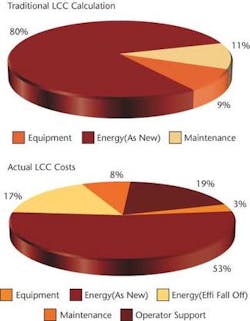Wastewater pumps selection must include all factors, besides LCC
By Mark Redit
For many years, Life Cycle Cost calculation has been used to evaluate selected pumps to determine which provides the user with the most cost effective solutions. In recent years, this type of calculation has been further developed, but in most cases end users continue to use the LCC calculation in its most basic form.
This basic calculation, which includes initial cost, new energy and maintenance costs, when used for sewage application, drives manufacturers, equipment suppliers and specifiers towards selecting equipment that does not give the best value for the customer. In many cases, the calculation steers the end users towards choosing equipment that has high efficiency when new, but results in significant on-site support costs to fix blockages and very high efficiency losses caused by wear.
It also penalises many design features that have been proved to significantly reduce operator support costs and efficiency losses as a result of wear, such as:
• Designs that have good solids handling capabilities and, therefore, less on-site support costs are penalised when compared to high efficiency designs that block on a regular basis.
• Increasing the number of impeller vanes improves efficiency in many cases; however this greatly reduces solids handling capability.
• Designs with adjustment features that increase efficiency on site without replacing parts help lower energy costs over the life of the unit. These designs are penalised against low-cost simple designs without this feature.
The existing basic calculation does not work for sewage applications. Why? The existing LCC calculation was originally applied to large pumps with high utilisation running on clean non-aggressive application. This same calculation cannot work for sewage applications because many of the costs of running this type of equipment are not included in the calculation. The benefits from improved design for solids handling or wear resistance cannot be evaluated since the cost-saving benefit is not seen in the traditional LCC calculation.
Another consideration is motor size. Generally, the smaller the pump, the more inaccurate becomes the basic LCC calculation. A high percentage of pumps installed in sewage applications are below 30 kw in size.
The on-site support costs of smaller equipment is the most critical factor. The cost of attending site remains very similar for all pumps up to approx 50 kw; therefore the percentage of these costs for the LCC of the pump becomes more significant for smaller pumps.
Traditional thinking has always dictated that when selecting pumping equipment the pumps with the best efficiency should be chosen. Another traditional position is that the cost of power to operate equipment is always the highest percentage of the LCC costs. Both of these comments are true, but efficiency should not be at the cost of increased operator support costs. Users should develop clear strategies based on pump size and application as to which impeller type should be used and the consequences of that choice.
Pump size should be a major factor in deciding this strategy along with the need for more regular adjustment to maintain high efficiency pumps.
Pump selection is clearly an important first step in achieving the best LCC, but users should be aware that on average 45% of the total LCC costs are directly influenced by the quality of equipment O&M.
Clearly, LCC evaluation does have value when selecting equipment; however it must be tailored based on the type of equipment and application for which it is being used. To achieve any benefit from LCC modelling, users must focus on all major costs including operator support costs, blockage and increased energy costs as a result of wear (efficiency fall off).
LCC modelling can deliver cost savings, but this also depends on how the user operates and maintains the equipment. Making the correct selection is only the first step.
Author's Note
Marc Redit is the service director for ABS Pumps, who is based in the London, UK office. For more information, visit the website: www.abspumps.com


